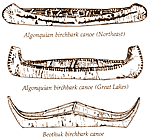Native American Transportation
Long before the wheel and the horse were brought to North America , Native Americans devised many ways of getting from place to place. They used boats to cross rivers and even oceans, and sleds and toboggans to travel on snow or ice. While the travois was used to carry people and their belongings across the plains.
click on photos for a larger view
Dugout canoe

Dugout canoes are boats made from hollowed out logs. They were the most common and widespread type of Native American boat. To make a dugout, a log was hollowed out using woodworking tools such as chisels, gouges, wedges and adzes. Some tribes such as those living on the Pacific Northwest coast, built dugout canoes that were almost 100 feet long by seven feet wide that were capable of holding 60 or more people. These huge boats were capable of ocean travel.
Bull Boat

Bull boats are circular boats made from a willow tree frame covered with a buffalo skin stretched over it. The hide was then sealed with animal fat to make the boat water proof. Bull boats took some skill to navigate because of their shape. They were however, a favorite of the Mandan , Hidatsa and Arikara.
Kayak and Umiaks

Kayaks are boats used by the people living in the far north or arctic region of North America . Kayaks were made from a wooden frame covered by a seal or walrus hide. Most were one seater, but two seaters were also made. The kayaks had sealed cockpits to keep them from sinking. Umiaks are larger, open, flat bottomed boats that could carry eight to ten people at a time.
Bark Canoe

Bark canoes are craft consisting of a framework of saplings covered by bark. The bark of birch trees was the best, followed by elm and spruce. Bark canoes were lightweight and portable. The tribes living in the Northeast and Subarctic were the ones who depended on bark canoes the most.
Balsa Boat

Balsa boats are boats made from bulrushes tied in bundles in a cylinder like shape. The thule plant is especially preferred because of its light weight and its strength. Balsa boats are usually between 10 and 15 feet long. Over extended periods of use, the boats would become waterlogged, but could be reused if allowed to dry out in the sun. Tribes living in California , Great Basin and parts of the Southwest made use of balsa boats.
Plank boats

Plank boats were made from sections of wooden planks held together with leather or plant fiber binding and sealed with naturally occurring asphalt. No intact plank boats have ever been found. Plank boats were double bowed, meaning they had a bow in front and the back presumingly to catch changing ocean currents while being used to travel and fish from. Plank boats are thought to have been up to 25 feet long. The Chumash of California are said to have developed this unique type of boat.
Travois

Travios were a wooden frame in the shape of a "V" used by the peoples of the Plains to carry their belongings as they followed migrating herds of buffalo. The closed end of the travois was over an animal's shoulders with the open end dragging on the ground. Webbing or a seat was tied to the middle section of the "V" to hold goods or even people. Dogs were the animals first used to carry a travois, but later on horses, because of their strength, replaced dogs.
Sleds

The people of the Far North used sleds pulled by dogs to travel from place to place during the winter. A sled consisted of a wood or hide platforms raised off the surface of the snow with wood or bone runners.
Toboggan

Toboggans were invented by the sub arctic peoples. Toboggans were wooden platforms that rested directly on the snow. The front of a toboggan was curled back and rope or twine made from the inner fiber of trees was attached in order to pull the toboggan. A toboggan was usually between 10 to 12 feet long and was usually pulled by the women instead of the men, or even dogs.
Snow Shoes
